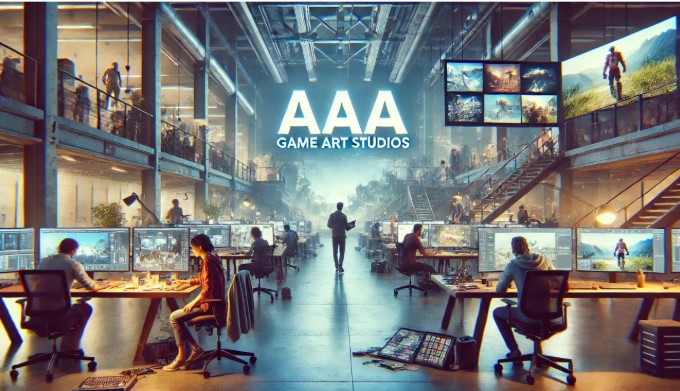In today’s gaming industry, visuals are no longer just an accessory to gameplay—they are the heart of immersion. Players expect cinematic quality, hyper-realistic environments, and characters that feel alive. This demand has pushed game design companies to collaborate with specialized AAA game art studios to bring cutting-edge visuals into their projects.
But what does this collaboration really look like? And why are these partnerships shaping the future of next-gen gaming visuals? Let’s dive into how studios work together to elevate modern gaming experiences.
The Rising Bar for Game Visuals
When you think about the first time you played an iconic open-world title like GTA San Andreas, the visuals were groundbreaking for their time. But fast forward to today, and players expect much more. They want realistic reflections, lifelike skin textures, cinematic cutscenes, and seamless transitions between gameplay and storytelling.
Technology like Unreal Engine 5 and Unity’s HDRP has set the stage for this leap, but software alone can’t deliver magic. It’s the collaboration between concept artists, environment designers, animators, and technical art specialists that transforms pixels into living worlds. This is exactly where AAA art studios come in.
Why Game Design Companies Turn to AAA Art Studios
Game design companies often handle the core aspects of gameplay mechanics, storytelling, and system architecture. However, producing top-tier art requires specialized skill sets and massive pipelines. Outsourcing or partnering with an AAA art studio allows design teams to:
- Tap Into Specialized Expertise
These studios house veteran artists who specialize in character sculpting, environment design, VFX, and cinematic animation. Their expertise ensures every visual asset meets industry-leading standards. - Scale Art Production Efficiently
Large-scale games require thousands of unique assets. Instead of overburdening internal teams, game design companies can scale production by working with external studios equipped to handle high-volume art pipelines. - Focus on Gameplay While Maintaining Quality
By delegating art-heavy tasks, companies can focus on refining mechanics, balancing levels, and optimizing user experience. Meanwhile, the art studio ensures visuals remain breathtaking.
From Sketch to Screen: The Collaborative Workflow
A collaboration between a design company and an AAA art studio often follows a structured process:
- Concept Phase – Game designers outline the vision: tone, narrative, and mood boards. Artists from the studio begin creating concept sketches to capture the essence of characters and environments.
- Prototyping and Feedback – Early prototypes are shared between both teams. This back-and-forth ensures art direction aligns with gameplay requirements.
- Asset Production – The studio begins large-scale production: 3D modeling, texturing, lighting, and animation. Each asset undergoes multiple quality checks before integration.
- Engine Integration – Assets are tested within the actual game engine. The collaborative fine-tuning ensures the visuals don’t just look good but also perform well without lag or crashes.
This workflow ensures that both creativity and technical efficiency are prioritized, resulting in stunning visuals that complement gameplay seamlessly.
Real-World Examples of the Impact
Think about the detailed cities in Cyberpunk 2077 or the breathtaking landscapes of Horizon Forbidden West. Behind these visuals are large teams of designers supported by external AAA art studios. Even indie developers are now exploring partnerships with these studios to make their games stand out in an oversaturated market.
For instance, a mid-sized design company creating an RPG might outsource their creature design to an art studio that specializes in high-poly sculpting. The result? Unique monsters that look as terrifying as they play, adding immense value to player immersion.
Next-Gen Visual Trends Driven by AAA Studios
The collaboration doesn’t just solve production bottlenecks; it drives innovation. Some of the emerging visual trends pioneered by AAA studios include:
- Photorealistic Characters using advanced motion capture combined with hand-painted artistry.
- Procedural Environments that make vast open worlds feel endlessly unique.
- Cinematic Storytelling blending in-game cutscenes with Hollywood-grade visual effects.
- XR and Immersive Visuals designed to support VR, AR, and metaverse experiences.
These advancements ensure that every generation of gaming raises the visual benchmark.
The Future of Collaborative Game Art
As the industry moves toward even more complex experiences—think fully persistent open worlds and interactive metaverses—the demand for specialized art will only increase. Game design companies will lean even more heavily on AAA art studios not just for manpower, but also for innovation.
This trend doesn’t only benefit big-budget studios. Smaller developers who strategically collaborate with AAA art teams can achieve visuals that rival those of blockbuster titles, helping them compete in a crowded marketplace.
Conclusion
The success of modern games is no longer measured solely by gameplay mechanics or storylines. Visuals play a critical role in how players connect with a game. This is why collaborations between game design companies and an AAA game art studio have become a cornerstone of next-gen development.
By combining design expertise with specialized art pipelines, the gaming industry is crafting experiences that are more immersive, visually stunning, and emotionally engaging than ever before. For players, this means every new release feels like stepping into a living, breathing world—a standard that keeps the industry moving forward.


